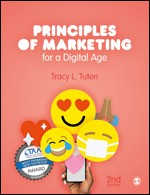Harnessing the Power of Social Learning in Teaching Marketing
Dr. Tracy L. Tuten explores the power of social learning in teaching marketing, emphasizing the importance of collaboration, resource sharing, and the use of platforms like Perusall to foster a sense of community and enhance the educational experience, based on an online reading group of her book Principles of Marketing for a Digital Age.
As a marketing professor, I have spent years in the field and have seen the industry transform and evolve into what it is today. With the advent of digital technology, marketing has taken on a whole new level of complexity, and it has become an increasingly challenging, as well as intriguing, quest for innovative teaching methods to equip our students with the skills they need to thrive. What I have found is that the right resources and collaboration are key: talking to my fellow professors, having a peek at what resources they use, and exchanging best practices are lifelines in my career.
I recently had the pleasure of running an online book event on the Perusall platform, where marketing professors socially read my textbook, Principles of Marketing for a Digital Age, and engaged in discussions about teaching practices in their principles of marketing courses. (You can still access the reading group here and see for yourself). It was an incredible experience to see so many minds come together to discuss a topic that is so crucial to the success of businesses in today’s world. What sets Principles of Marketing for a Digital Age apart from other marketing textbooks out there? It recognizes the significant impact that digital technology has had on the marketing industry.
But what made the Perusall book event truly special was the social aspect of it all. As the participants read the book, they were able to engage in discussions, ask questions, and share their own experiences and teaching practices. The platform allowed them to collaborate and learn from one another, creating a sense of community and a deeper understanding of the material.
It was amazing to see how the book came to life through the participants’ discussions. They talked about their struggles and successes in teaching principles of marketing, shared tips on engaging students, and brainstormed new ideas for course activities. It was truly inspiring to witness how the book served as a catalyst for their conversations and how they were able to take the concepts and apply them in their own unique ways.
As a professor, it’s always my goal to provide my students with the best possible learning experience. But seeing the Perusall book event and the discussions it sparked has shown me that learning doesn’t have to be a solitary experience. By leveraging digital platforms like Perusall, we can create a collaborative and interactive learning environment that enriches the educational experience for everyone involved.
Principles of Marketing for a Digital Age is more than just a textbook. It’s a comprehensive guide to navigating the complex world of marketing in the digital age, and it’s a tool for fostering a sense of community and collaboration among students and professors alike. And the Perusall book event was a testament to the power of social learning; I’m excited to see how this platform and others like it will continue to shape the future of education.
Collaboration and the exploration of best practices have become indispensable in my pursuit of delivering high-quality marketing education. By embracing complexity, engaging with peers, and harnessing the right resources, we can equip our students with the skills and knowledge necessary to thrive in the dynamic landscape of modern marketing. Together, we can shape the marketers of tomorrow and contribute to the continued evolution of this vibrant industry.
So, what sets Principles of Marketing for a Digital Age apart from other marketing textbooks out there? In the book, we explore how Industry 4.0 affects all areas of the marketing mix. Another unique aspect of the textbook is that it encourages students to think creatively and strategically about marketing. It emphasizes the importance of understanding customer needs and desires and how to effectively communicate with them. The book takes a strategic view beginning with understanding buyers, and targeting and positioning, followed by the role of market research, strategic planning. There is a deep dive into the marketing mix including customer experience and brand management. And, of course, marketing metrics wraps it all up. The instructor resources feature flipped class lecture plans to help bring the material to life.






























































































Hi Tracy,
I wanted to let you know that I’ve been reading your work on Principles of Marketing for a Digital Age. I’m truly impressed by your writing abilities. You have researched a lot and done an excellent work. If you have interest on recent digital trends, read my article here